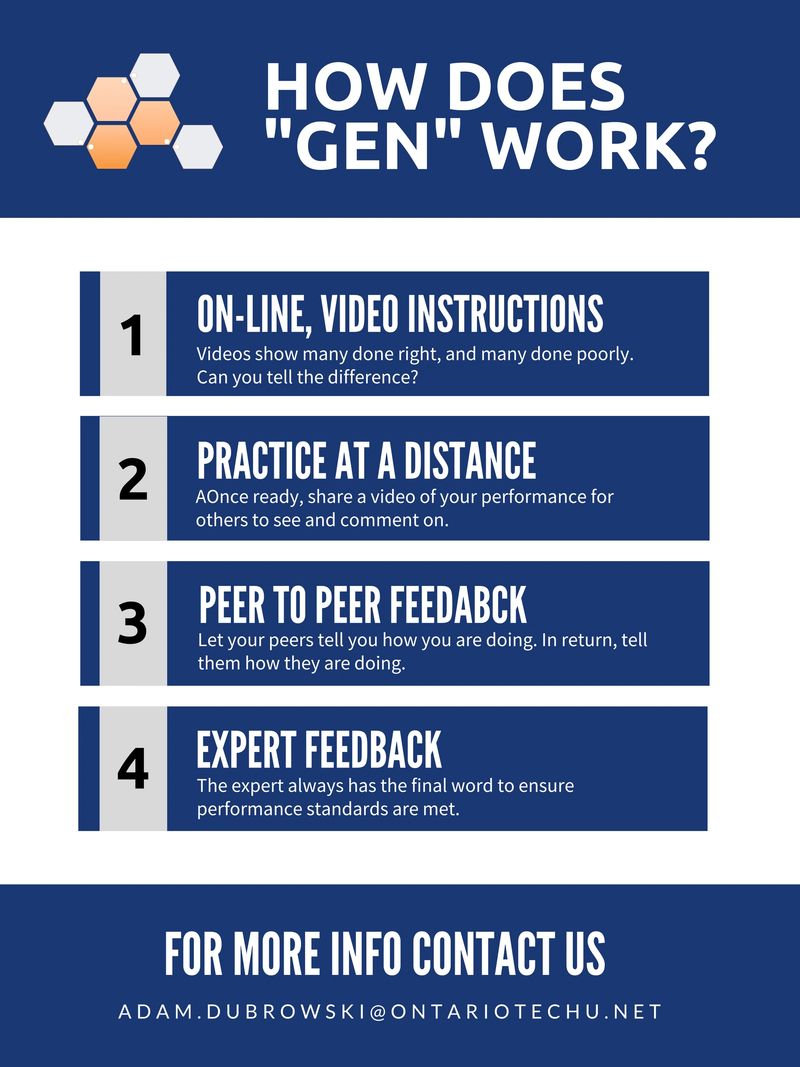GEN (Gamified Educational Network) is a virtual learning management system that relies on principles of active observational practice, sharing of videos, and peer-to-peer, expert facilitated feedback.

How is active observational practice achieved?
We use a combination of computer based video instructions (CBVI) and “spot the difference” approaches. More specifically, we use scripted vignettes of performances some flawless, and some with flaws. The learners need to watch all of the videos and pick the flaws using checklists and global rating scores.
The theoretical underpinnings for this come from The Levels of Processing model, created by Fergus I. M. Craik and Robert S. Lockhart in 1972. The model describes memory recall of stimuli as a function of the depth of mental processing. Deeper levels of analysis produce more elaborate, longer-lasting, and stronger memory traces than shallow levels of analysis. Depth of processing falls on a shallow to deep continuum. Shallow processing (e.g., processing based on phonemic and orthographic components) leads to a fragile memory trace that is susceptible to rapid decay. Conversely, deep processing (e.g., semantic processing) results in a more durable memory trace.
In this conception, by asking the learners to not only watch the videos, but look for mistakes in a series of videos that are seemingly the same, we are forcing them to engage in deeper levels of analysis, hypothetically resulting in deeper levels of learning.
Why share videos?
In the lab or at home, learners can practice independently. However, we do not want them to develop bad habits, therefore every now and then, whenever they feel like they are ready, they need to “challenge” a test. This consists of capturing the performance and uploading it to GEN, where their peers and instructors are notified to provide feedback.
Is this a feasible approach?
More than a decade ago, we have studied this phenomenon. Using a randomized controlled study design, we asked the question whether junior medical students can learn suturing skills to the same degree when using computer based video institutions and self-directed learning, as they do when instructed by experts during a prescribed learning session. What we have shown was supporting this idea. Students who engaged in self-directed learning (i.e. they could quit practice whenever they “felt” like they are proficient) learned the skills to a similar proficiency than students who were forced to practice in a more traditional way. Furthermore, forcing the self-directed learners to work a little more (extra practice after they felt they were proficient) did not result in extra learning, suggesting that when they felt that they were done - they were done!
What about feedback?
All learning theories agree that next to practice, feedback is the most important variable facilitating learning. Here, we employ a number of techniques: peer-assessments, peer-feedback, checklists, discussion boards, with or without experts. At present, most of our research focusses on the question of what is the best way to provide peer and expert facilitated feedback, and how does this interact with the types of learner and skills.
Where is the gamification in GEN?
Gamification elements were recently introduced to motivate the learners. After endless cycles of user testing, our parsimonious gamification set utilizes three techniques:
- Point-based system: implemented in a manner similar to the “Reddit” entertainment, social networking, and news website which supports peer- based assessment where-by peers rate the quality of others comments or interactions;
- Leaderboard: this social comparative feedback component provides learners with information regarding how well they are doing with respect to their peers. Such comparative information is provided both individually and in a general context by showing the learner position on a private individual leaderboard (e.g., ‘Forum likes: #2’) ensuring that the learners do not have access to the scores of their peers, avoiding comparisons that could be a detriment to motivation. Learners also get access to how many points they received in each course section through an individual scoreboard;
- Module division: implemented as segmented progress bar, that allow learners to track their progress in each course and also in each individual course component.